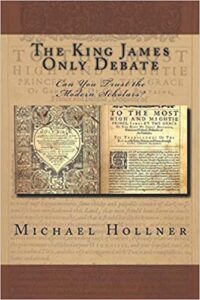 (Read part 1, part 2, part 3, part 4). Part 5 will cover chapter 2, “The Deleted and Missing Words of God.” In the table of contents this is called “Missing Verses and Words.” Bible-believers have been pointing out the missing verses, clauses, phrases, and words from the New Testament of modern versions since the Revised Version came out in 1881. In my book King James, His Bible, and Its Translators (2nd ed.), in chapter 26, “The King James Version and Modern Versions,” there is an extensive list of the verses, clauses, phrases, and words omitted in the New Testament of modern versions. Hollner has nothing new to add here. And if he is going to discuss omissions in the Bible, then he should at least get the total number of words in the King James Bible correct. His figure of 783,820 words is not even close to the true number of 789,630 (p. 69).
(Read part 1, part 2, part 3, part 4). Part 5 will cover chapter 2, “The Deleted and Missing Words of God.” In the table of contents this is called “Missing Verses and Words.” Bible-believers have been pointing out the missing verses, clauses, phrases, and words from the New Testament of modern versions since the Revised Version came out in 1881. In my book King James, His Bible, and Its Translators (2nd ed.), in chapter 26, “The King James Version and Modern Versions,” there is an extensive list of the verses, clauses, phrases, and words omitted in the New Testament of modern versions. Hollner has nothing new to add here. And if he is going to discuss omissions in the Bible, then he should at least get the total number of words in the King James Bible correct. His figure of 783,820 words is not even close to the true number of 789,630 (p. 69).
I am glad to know that the author “will participate in exploring the Greek a few times in this book to let the audience know that we do have the necessary skills to be able to alert the Church” (p. 55). One would think, then, that Hollner would refer throughout to the latest edition (the 28th) of the Nestle-Aland Greek New Testament, published in 2012, instead of the 27th edition, published in 1993. It is not correct to say that “with every new Nestle’s Greek edition that comes out, changes are being made” (p. 70). The text in the 26th and 27th editions is the same.
Hollner has a very simplistic view of textual criticism: if a Greek word or phrase appears in the majority of manuscripts, then it is the correct word or phrase. He changes his tune, however, when he discusses 1 John 5:7 in chapter 3.
The picture of the author next to the picture of Dean Burgon under the heading of “The Bible Believers Team of Divine Inspiration and Holy Preservation” is laughable (p. 54). Not only would Dean Burgon never join the Dean Burgon Society, he would never make the statements about the King James Bible that Hollner does.
Mistakes abound. I note the following. The combination “very-best” (p. 52) is not a word, and neither is it necessary to add “very” to “best,” for if something is the best, then adding “very” to it adds nothing. Not sure why Hollner refers to the New King James Version as “so-called” (pgs. 66 & 76) since that is its actual name. But at least he gets the name right. It is incorrect to refer to the NASB as the NAS (pgs. 70 & 82). And to refer to “the N.I.V. and the N.A.S. versions” (p. 51) is incorrect, and not just because the periods are unnecessary (Hollner uses NIV on pgs. 68 & 70). He should have said “The NIV and the NASB” or “The New International and the New American Standard versions.” Similarly, he can’t decide whether to use “T.R.” (pgs. 63 & 72) or “TR” (pgs. 55 & 56). Like he does in the rest of the book, Hollner capitalizes words that do not need to be capitalized. But then he carelessly fails to capitalize the word “latin” (p. 65). It is worse than careless to omit spaces between words (pgs. 55 & 65). The percent symbol (pgs. 56, 57, & 84) should be spelled out. He refers to his first chapter, one of the few that actually has the same title as that listed in the table of contents, as “Advantage KJV” instead of “The King James Advantage” (p. 55). It is inexcusable to cite a source as “Ruckman; Riplinger” (p. 69) with no book titles or page numbers. Stay tuned for the sixth installment.